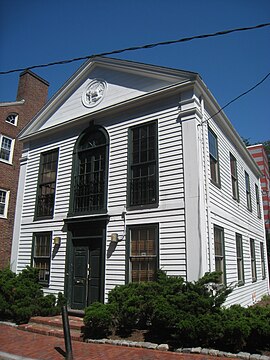 | |
 Headquarters of The Harvard Advocate at 21 South Street, Cambridge, Massachusetts, United States | |
| Categories | Art, culture, fiction, humor |
|---|---|
| Frequency | Quarterly |
| Founder |
|
| Founded | May 11, 1866 [1] |
| Country | United States |
| Website | www |
| ISSN | 0017-8004 |
| OCLC | 8158155 |
The Harvard Advocate, the art and literary magazine of Harvard College, is the oldest continuously published college art and literary magazine in the United States. The magazine (published then in newspaper format) was founded by Charles S. Gage and William G. Peckham in 1866 and, except for a hiatus during the last years of World War II, has published continuously since then. In 1916, The New York Times published a commemoration of the Advocate's fiftieth anniversary. [2] Fifty years after that, Donald Hall wrote in The New York Times Book Review : "In the world of the college—where every generation is born, grows old and dies in four years—it is rare for an institution to survive a decade, much less a century. Yet the Harvard Advocate, the venerable undergraduate literary magazine, celebrated its centennial this month." [3] Its current offices are a two-story wood-frame house at 21 South Street, near Harvard Square and the university campus.
Contents
- History
- Founding and early years
- After World War II
- 21st century
- Notable past members
- Academics and criticism
- Art, architecture, and engineering
- Business and philanthropy
- Editing and translation
- Fiction
- Film, theater, television, and entertainment
- Journalism and non-fiction writing
- Law and politics
- Poetry
- Science, technology, medicine, and mathematics
- Past presidents[10]
- See also
- References
- External links
Today, the Harvard Advocate publishes quarterly. Its mission is to "publish the best art, fiction, poetry and prose the Harvard undergraduate community has to offer." [4] It also accepts submissions from professional writers and artists beyond the Harvard community.


